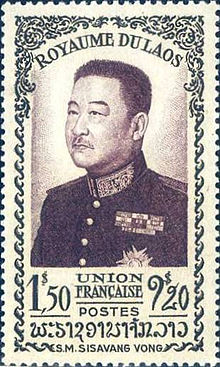
Laos, officially the Lao People's Democratic Republic, is the only landlocked country in Southeast Asia. At the heart of the Indochinese Peninsula, Laos is bordered by Myanmar and China to the northwest, Vietnam to the east, Cambodia to the southeast, and Thailand to the west and southwest. Its capital and largest city is Vientiane.

Philately is the study of postage stamps and postal history. It also refers to the collection and appreciation of stamps and other philatelic products. While closely associated with stamp collecting and the study of postage, it is possible to be a philatelist without owning any stamps. For instance, the stamps being studied may be very rare or reside only in museums.
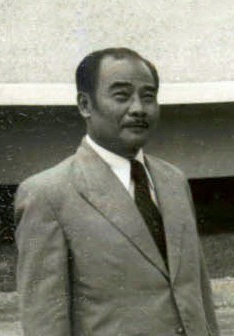
Prince Souphanouvong, nicknamed the Red Prince, was along with his half-brother Prince Souvanna Phouma and Prince Boun Oum of Champasak, one of the "Three Princes" who represented respectively the communist (pro-Vietnam), neutralist and royalist political factions in Laos. He was the President of Laos from December 1975 to October 1986.
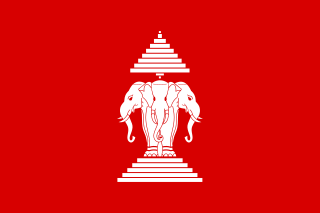
The Kingdom of Laos was the form of government in Laos from 1947 to 1975. Located in Southeast Asia at the heart of the Indochinese Peninsula, it was bordered by Burma and China to the northwest, North Vietnam to the east, Cambodia to the southeast, and Thailand to the west and southwest. The country was governed as a constitutional monarchy beginning with its independence on 9 November 1953. It survived until December 1975, when its last king, Sisavang Vatthana, surrendered the throne to the Pathet Lao during the civil war in Laos, who abolished the monarchy in favour of a Marxist–Leninist state called the Lao People's Democratic Republic, which has controlled Laos ever since.

The Pathet Lao, officially the Lao People's Liberation Army, was a communist political movement and organization in Laos, formed in the mid-20th century. The group ultimately conquered the entire country of Laos in 1975, after the Laotian Civil War. The Pathet Lao were always closely associated and dependent on Vietnamese communists and North Vietnam since their foundation, with the group being established after advice from Hanoi to create a Laotian counterpart of the Viet Minh later Viet Cong. During the civil war, it was effectively organised, equipped and even led by the People's Army of Vietnam (PAVN). They fought against the anti-communist forces in the Vietnam War. Eventually, the term became the generic name for Laotian communists. Under orders from Mao Zedong, the People's Liberation Army provided 115,000 guns, 920,000 grenades and 170 million bullets, and trained more than 700 of its military officers.

The Laotian Civil War was waged between the Communist Pathet Lao and the Royal Lao Government from 23 May 1959 to 2 December 1975. The Kingdom of Laos was a covert theater during the Vietnam War with both sides receiving heavy external support in a proxy war between the global Cold War superpowers. The fighting also involved the North Vietnamese, South Vietnamese, American and Thai armies, both directly and through irregular proxies. The war is known as the Secret War among the American CIA Special Activities Center, and Hmong and Mien veterans of the conflict.
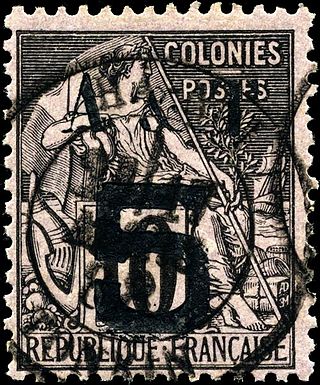
This is a survey of the postage stamps and postal history of Indochina.
This is a survey of the postage stamps and postal history of Afghanistan.

The flag of Laos consists of three horizontal stripes, with the middle stripe in blue being twice the height of the top and bottom red stripes. In the middle is a white disc, the diameter of the disc is 4⁄5 the height of the blue stripe. The flag ratio is 2:3.

The kip is the currency of Laos since 1955. Historically, one kip was divided into 100 att (ອັດ) which are no longer in regular use. The term derives from ກີບ kì:p, a Lao word meaning "ingot."
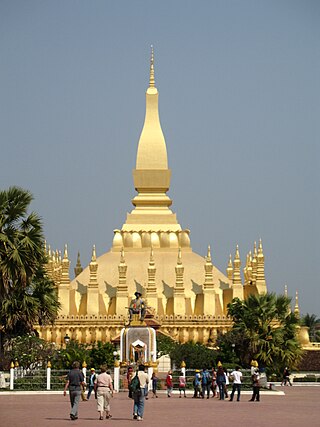
Theravada Buddhism is the largest religion in Laos, which is practiced by 66% of the population. Lao Buddhism is a unique version of Theravada Buddhism and is at the basis of ethnic Lao culture. Buddhism in Laos is often closely tied to animist beliefs and belief in ancestral spirits, particularly in rural areas.

This article details the history of Laos from 1945 to the present.
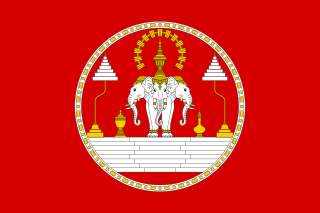
The Royal Lao Government was the ruling authority in the Kingdom of Laos from 1947 until the communist seizure of power in December 1975 and the proclamation of the Lao People's Democratic Republic. The Franco-Lao Treaty of 1953 gave Laos full independence but the following years were marked by a rivalry between the neutralists under Prince Souvanna Phouma, the right wing under Prince Boun Oum of Champassak, and the left-wing, Lao Patriotic Front under Prince Souphanouvong and future Prime Minister Kaysone Phomvihane. During this period, a number of unsuccessful attempts were made to establish coalition governments.
Cambodia used the postage stamps of Indochina until the early 1950s. In 1949 Cambodia became an associated state of the French Union but gained independence in 1953 and left the Union in 1955.
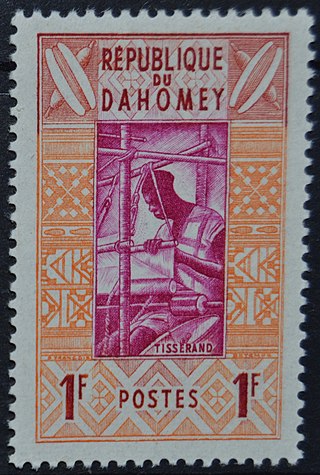
This is a survey of the postage stamps and postal history of Benin, formerly Dahomey.

This is a survey of the postage stamps and postal history of Réunion.
This is a survey of the postage stamps and postal history of Djibouti, known as the French Territory of the Afars and Issas before independence, and as French Somaliland before that.

This is a survey of the postage stamps and postal history of the Republic of the Congo, a former French colony known as Middle Congo or French Congo, and now often known simply as The Congo.
This is a survey of the postage stamps and postal history of Madagascar, briefly also known as Malagasy.
